Can't Draw or Dimension From One View to Another
Shortcut: d
![]() This functionality is currently available only on browser.
This functionality is currently available only on browser.
![]()
When defining dimensions for a drawing, you will notice that orange snap points appear when you hover over a line or point. There are 4 types of snap points:
- Square snap points indicate end points
- Triangle snap points indicate midpoints
- Diamond snap points on a quad point of a circle or arc indicate one of the quadrants of the circle
- Circle snap points indicate an arc or circle's center; once a dimension snap point exists on a circle or arc's center, you can click and drag the point to a quadrant point.
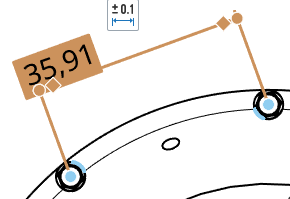
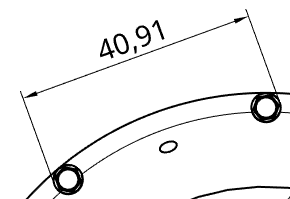
Midpoints and quad points are disabled during dimensioning for ease of selecting appropriate dimension points. However, after a dimension has been placed, editing the dimension provides access to these midpoints and quad points.
Use keyboard shortcut Shift-q to quickly toggle on midpoints and quad points for the current command. Shift-q again to toggle them off.
Once the snap point is visible, the point has been snapped to and you can click. There is no need to click directly on the point once it is visible. While moving the mouse to place the dimension, you'll notice thin, dashed lines as the cursor passes near other entities. These are inferencing lines that you can align the dimension to; simply click when you see the line appear to align the dimension to that line.
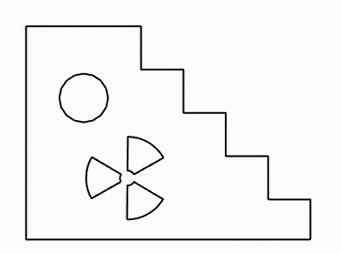
You can dimension to hidden lines (after using the command "Show hidden lines").
Editing the value of a dimension causes it to be converted to an Overridden dimension. See Troubleshooting dimensions.
Once a dimension is created, hover over it to see which entities are involved in the dimension. The entities turn blue upon hover:

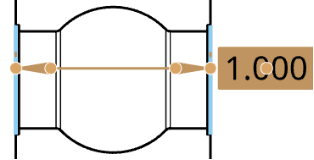
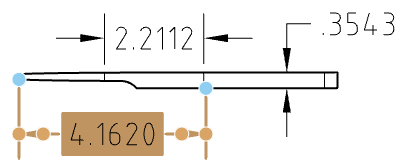
You can edit grip points of an existing dimension, if necessary. Click and drag any grip point to another edge, point, arc, circle, or circle center. Associations are maintained on other grip points. For example, in the illustrations below, the right grip point of the dimension is dragged from the point to the edge:


You can drag the dimension text simply by clicking and dragging. There is no need for a grip point on the text.
When an edge is selected, click again (even in the middle of dimensioning) to deselect it and select a different edge.
![]() Dimension
Dimension![]()
Shortcut: d
The Dimension tool for drawings work much like the Dimension tool for sketches. Activate the tool (click the icon or use the d shortcut), then:
- Click a highlighted drawing entity (circle, arc, circle center, line, or point).
- Click a second highlighted drawing entity.
- Click to place the dimension in the drawing.
You can edit a dimension after placement by clicking and dragging a grip point. As you move the cursor, drawing entities highlight to indicate you can dimension to them.
![]() Linear dimensions on circular parts
Linear dimensions on circular parts
It is possible to automatically add a diameter symbol to a linear dimension if the lines selected are on the same edge representing an arc or circle on its edge. This works in projected views only.
The image below shows a projected side view of a cylinder part. Select the top corner snap point. Then select the bottom corner snap point. This results in a normal linear dimension, as shown below left. However, if you first select the top edge, and then select the bottom edge, this results in the same linear dimension, but with the diameter symbol applied (shown below right).

You can use the Line-to-line tool to automatically add a diameter symbol in the same way as with the Dimension tool. The line-to-line tool works on both projected and section views.
![]() Wall thickness of concentric circles
Wall thickness of concentric circles
You can automatically dimension the wall thickness of two concentric circles. After selecting the Dimension tool, click each circle and drag to place the dimension. The tool automatically dimensions the linear distance between the two circles:

Below are entity-specific dimension tools. For each tool, only specific entity types are highlighted as you move the cursor.
![]() Chamfer dimension
Chamfer dimension![]()
Place a note or dimensions on a chamfered edge.
- Click
 .
. - Click the chamfered edge and an adjacent edge.
- Move the cursor away from the edges to preview the dimension.
- Click to place the note or dimensions.
To alter the style of the chamfer dimension (note or dimension), select the preferred style in the Properties panel, Dimensions tab, Chamfer section. For more information, see Properties

To include a prefix for the chamfer dimension, double-click the dimension to open the dialog:

Adjust the chamfer dimension formatting as explained in Dimension.
![]() Maximum or minimum dimension
Maximum or minimum dimension![]()
Shortcut: m
Place a minimum or maximum dimension directly to any combination of arcs, circles and any other geometry type, excluding curves.
- Click
 .
. - Select a combination of one arc/circle and any other geometry type, excluding curves.
- Drag to move the dimension text to desired location.
- Click to place the dimension.
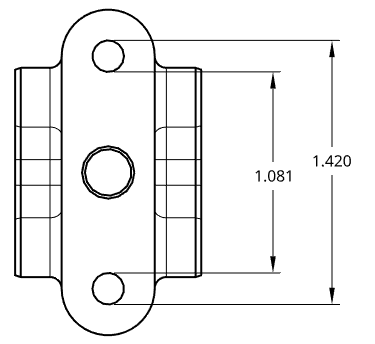
Despite clicking on the circle itself, the min-max dimension tool gives you the maximum or minimum dimension depending on where you click the entity; for example, the maximum distance, shown above as 1.420, was acquired by clicking on the top of the top circle and the bottom of the bottom circle
![]() 2 point linear dimension
2 point linear dimension![]()
Measure the distance between two points. Create horizontal, vertical, and rotated linear dimensions.
You must select two points. You cannot select a line.
- Click
 .
. - Hover over the drawing view to activate the snap points.
- Click when you see an appropriate snap point.
- Click when you see the second appropriate snap point.
- Drag to place the dimension box.
![]() Point-to-line dimension
Point-to-line dimension![]()
Measure the distance between a point and a line. Create horizontal, vertical, and rotated linear dimensions.
You must select one point and one line.
- Click
 .
. - Hover over the drawing view to activate the snap points.
- Click when you see an appropriate snap point.
- Click when you see the appropriate line highlighted.
- Drag to place the dimension box.
![]() Line-to-line dimension
Line-to-line dimension![]()
Create dimensions between parallel lines.
- Click
 .
. - Hover over the drawing view to activate the snap points.
- Click the first line highlight.
- Click the second line highlight. Note that only parallel lines will highlight for selection.
- Drag to place the dimension box.
It is possible to automatically add a diameter symbol to a linear dimension if the lines selected are on the same edge representing an arc or circle on its edge. See Linear dimensions on circular parts.
![]() Placing dimension text
Placing dimension text
After picking two entities the dimension is drawn in a preview mode to allow final placement:
- Dragging the text around during preview allows for the text to move outside of the extension lines, and also switch between horizontal, vertical, and aligned measurement modes:
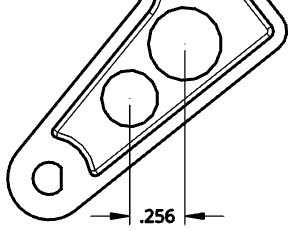
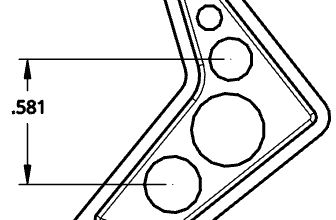
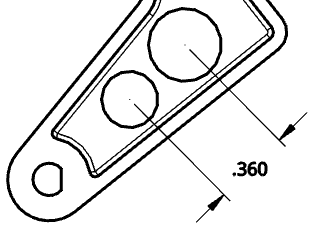
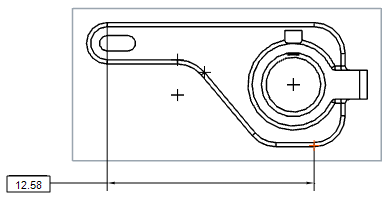
- Dragging the text away from the two chosen snap points up or down the drawing creates a horizontal dimension line:

- Dragging the text away from the two chosen snap points toward the side of the drawing creates a vertical dimension line:

- Dragging the text away in a direction perpendicular to a line through the two chosen snap points creates a dimension line parallel to the two chosen snap points:

- Horizontal and vertical projected snaps are also available during text placement. This allows for lining dimensions up with existing text/dimensions and other locations on the drawing:
Hover over a marker to wake up alignment. This is available in Preview mode only. Pass over other drawing entities to wake up alignment as well, like other views' entities.
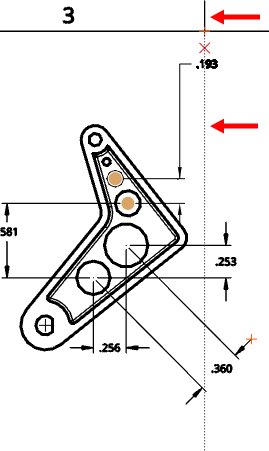
![]() Center marks on circular edges
Center marks on circular edges
When the dimension tool is selected, you can move the cursor over an edge representing a circular edge to 'wake up' the center mark. Once visible, this mark remains visible.
Upon moving the cursor over an edge, an orange circular snap point appears, with the vertical center marker:
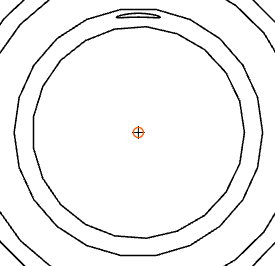
After hover, the orange snap point disappears but the marker remains:
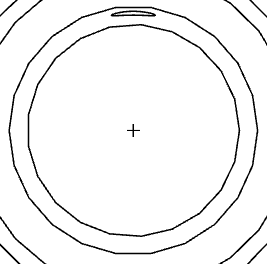
![]() Line-to-line angular dimension
Line-to-line angular dimension![]()
Measure the interior angle between the two legs and the exterior angle formed by two lines.
- Click
 .
. - Click two lines.
- Move the cursor between the lines to preview the inner angle dimension.

Line-to-line angular dimensions have a drag-able grip on the dimension arc for changing the angle to be measured:
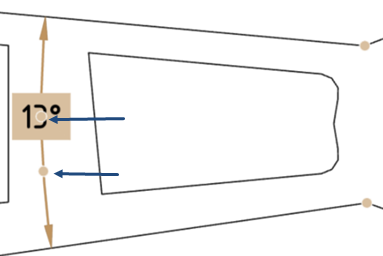
Drag the grip point across one of the infinite lines through the ends of the selected edges/points to change the measured value to the supplementary or vertical angle of the angle where the text was first placed.
Dimensions can be created not only for the angle, but also for its conjugate/reflex and supplementary angles. The example below displays two sketch lines in blue. The angle of 116.4°, its conjugate/reflex angle of 243.6°, and the supplementary angles of 63.6°, are all dimensioned.
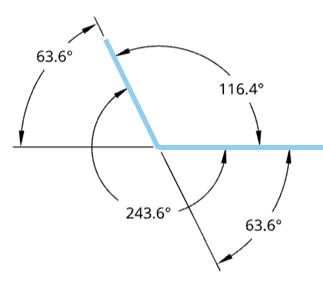
![]() 3 point angular dimension
3 point angular dimension![]()
Measure an angle by selecting 3 points, including a vertex and two points on the legs:
- Click
 .
. - Click the vertex.
- Click a point on each leg on the perimeter of the arc.
Angular dimensions have a drag-able grip on the dimension arc for changing the angle to be measured.
Drag that grip point across one of the infinite lines through the ends of the selected edges/points to change the measured value.
On 3-point angular dimensions it changes from the initial angle to the outside angle (360 minus initial angle).
Before drag (below):
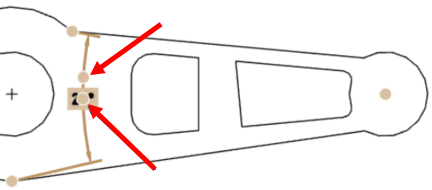
After drag (below):
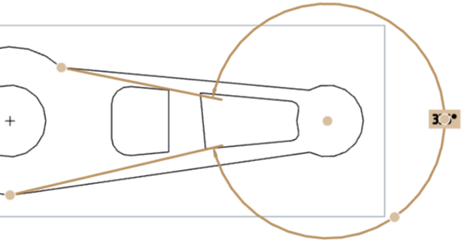
![]() Radial dimension
Radial dimension![]()
Shortcut: Shift+r
Measure the radial dimension of a circle or arc.
- Click
 .
. - Select the arc or circle.
- Move the cursor and click to place the dimension.
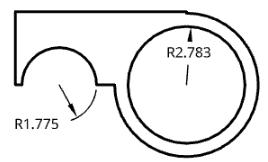
You have the ability to foreshorten a dimension line on an arc when the center point is at an inconvenient distance from the arc on the drawing. In this case, select the dimension, right-click and select Foreshorten. A jogged line appears, drag to the desired location and click to set the endpoint.To undo the foreshortened line, select the line, right-click and select Remove foreshorten.
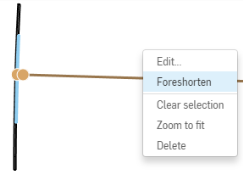
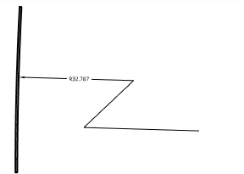
You can also add a Radial dimension to circles that are on either side of other geometry. For instance, the top and bottom circles below have two ellipses between them. The four sketches are lofted, and then a top view is placed in a Drawing. Radial dimensions are then added to both circles. If the circle is obscured, as is the case in the bottom circle in this example, a guide line is overlaid on top, as you add the dimension, ensuring the visibility of the circle.
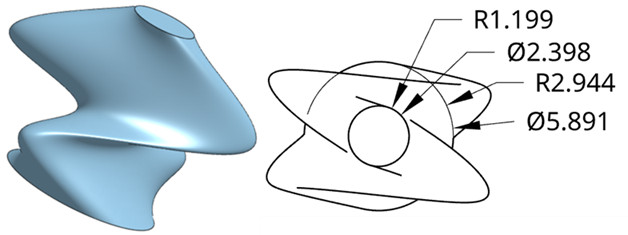
![]() Diameter dimension
Diameter dimension![]()
Shortcut: Shift+d
Measure the diameter of a circle or arc, including silhouette edges.
- Click
 .
. - Select the arc or circle.
- Move the cursor and click to place the dimension. A diameter symbol is included in the placement.
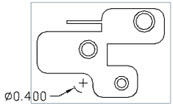
Placing a diameter dimension on a detail view or crop view of an arc or circle displays a foreshortened diameter dimension, as shown below.

To convert the foreshortened diameter dimension format to a direct dimension, right-click on the diameter and select Display as direct diameter (below left). This replaces the foreshortened dimension with a direct dimension (below right). This option is a toggle, so you can switch between the dimension styles at any time.

You can also add a Diameter dimension to circles that are on either side of other geometry. For instance, the top and bottom circles below have two ellipses between them. The four sketches are lofted, and then a top view is placed in a Drawing. Diameter dimensions are then added to both circles. If the circle is obscured, as is the case in the bottom circle in this example, a guide line is overlaid on top, as you add the dimension, ensuring the visibility of the circle.

![]() Ordinate dimension
Ordinate dimension![]()
Create ordinate dimensions (X, Y pairs) for a feature measured from a datum. Ordinate dimensions created as a group move together when one is moved.
- Click
 .
. - Click the point to serve as the datum (0, 0).
- Click each point in one direction (Y, for example) to associate with that datum point.
- Press Escape to exit the tool.
At this point, one Ordinate dimension group is created.
- Click
 .
. - Click the point to serve as the datum (0,0).
- Click each point in the other direction (X, for example) to associate with that datum point. This datum is able to be the same as the first datum chosen.
- Press Escape to exit the tool.
At this point, a second Ordinate dimension group is created.
If the orientation of the ordinate dimension is not correct, move the mouse around the datum point until the 0,0, dimension is in the correct orientation, then click to set its location on the drawing.
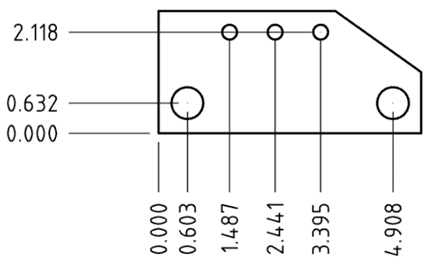
Working with ordinate dimensions
Right-click on an ordinate dimension access the context menu for the ordinate dimension group:
- Add to ordinate dimension group - Select to add another ordinate dimension to the existing group; click a point to act as a datum point.
- Edit - Select to open the Dimension palette for the ordinate dimension group.
- Reset ordinates - If you've moved the ordinate dimension out of its original alignment, select this option to automatically move it to its previous position.
- Clear selection - Clear all selected items.
- Zoom to fit - Zoom the drawing to fit in the view.
- Delete - Delete the selected items.
Tips
- Use the inferencing to make realigning the datum points easier. Click and drag a datum point (it doesn't matter if it's a jogged position or not) to activate inferencing guidelines.
For example, to unjog the .963 datum point below:
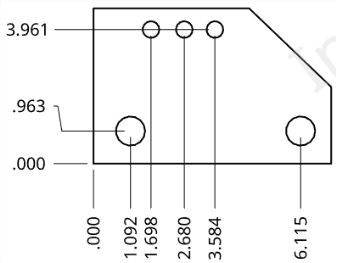
Click and drag until the desired inferencing guideline appears, then release to place the datum point.

The bold datum point (.963 to the left, above) is the point being realigned; the red crosses (plus signs) on each datum point are alignment snap indicators
The guidelines come in especially handy when trying to jog or unjog datum points.
- Grouped ordinate dimensions can be moved as a group or singly. Drag the middle snap point of the dimension, notice the dashed lines appear on all dimensions in the group, and drag the dimension to a new position and all members of the group move in sync:
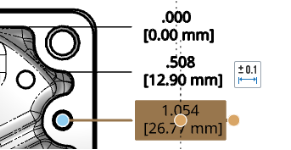
Use the outmost snap point (below, on the far right) to drag a singular dimension on its own:
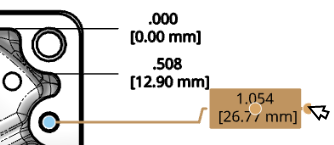
If you subsequently move any of the group, all are moved in their relative positions, as indicated by the dashed lines:
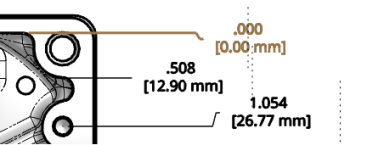
- Circular grip points at arrow bases flip the arrows to the opposite side of the dimension lines.
- Each direction must have a datum; each time you initiate the command from the toolbar, the first click establishes the datum point (0, 0).
- Each direction of dimensions (Y, for example) consists of an ordinate dimension group with a single datum. To add another value pair to that group, select an existing value in the group, right-click and select Add to ordinate dimension group. This activates the command and the next click establishes the additional dimension value:
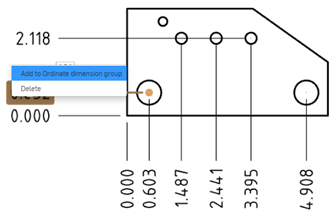

- If the drawing is updated such that the feature an ordinate dimension refers to is removed, the ordinate dimension remains and turns red. You can safely delete the dimension (right-click and select Delete, or select and press Delete).

- Drag the jog point, the grab point at the point in the leader where it jogs, to reposition the jog point. When you reposition the dimension, the leader will jog at the new point. You can line up all the jog points for a series of ordinate dimensions, then when you move one dimension, the jog points of all of them will stay aligned:

The red line and x, above, show the alignment of the red x jog point to the others
![]() Dimension palette
Dimension palette![]()
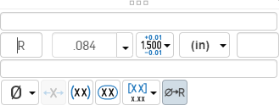
You have the ability to customize the appearance of a selected dimension with the Dimension palette. Selecting a dimension causes the dimension palette icon to appear.
- With no tool selected, select the dimension.
- The Dimension palette icon appears
 .
. - Hover over the icon and the palette opens:

- You can enter, in order from top to bottom of the palette:
- Above text - Enter the text or symbol to appear above the dimension value.
And then, for each of the primary dimension units and the dual dimension units, respectively:
- Prefix text - Enter the text to appear as a prefix to the dimension value.
- Precision - Select the depth of unit precision (zero to 8 decimal places).
Precision defined on a drawing dimension may be linked to the Properties panel through this Dimension palette by selecting the tolerance with "(Drawing)" beside it. Whenever the Properties panel tolerance precisions are updated, any dimension with the "(Drawing)" tolerance selected will also be updated. You can choose to link these properties (and unlink them) on a dimension-by-dimension basis.
- Tolerance display - Select None, Symmetrical, Deviation, Limits, or Basic.
- Select units - Select the units of your choice, currently selected units are displayed in the dropdown label:
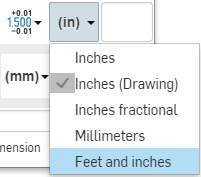
Choosing any of: Inches, Inches fractional, Millimeters, or Feet and Inches overrides the units for that dimension. If you later change the drawing units, the units for the dimension are not overridden. But you can change the units back to (Drawing) if you want to inherit the drawing properties again.
When you choose units, you set 2 properties in the drawing or on a dimension - the Units property and the Fractional display property.
- Show hide units - Toggle the display of units on and off.
- Suffix text - Enter the text to appear as a suffix to the dimension value.
- Below text - Enter the text or symbol to appear below the dimension value.
- Symbol dropdown - Select a symbol to insert from the dropdown:

Degree
Diameter
Center line
Counter sink
Depth
Counterbore
Square
Arc length
Plus/Minus - Reset text position - Toggle to reset the text to the previous location.
- Add parenthesis - Toggle to add or remove parenthesis around the dimension field.
- Dimension inspection - Toggle to add or remove an oval frame around the dimension to indicate this is an inspection dimension.
- Dual dimension - Toggle to specify whether to have a single unit dimension, single unit as specified for the drawing properties, or a dual unit dimension:


- Toggle Radius/Diameter dimension - Use this to change a radial dimension to diameter or vice versa.

You are also able to copy/paste into all text boxes, in dimensions and notes as well.
Adding symbolsCopy link
In the text box of the Dimension panel, you have the ability to add codes in order to display the symbols of your choice:
Drafting symbols
-
Degree (°), %%d
-
Plus minus (±), %%p
-
Diameter (Ø), %%c
Flipping dimension arrowsCopy link
Change the position of dimension arrows. Use on any dimensions that display arrows or ticks.
When you select dimensions, a node displays near dimension arrows or ticks. Clicking a node flips the arrows of the dimension.
To flip dimension arrows:
- In the graphics area, select the dimension to change.
- Drag the value to the new position (the arrows change accordingly).
Troubleshooting dimensionsCopy link
At times, you may run across issues that you need to resolve, some of these may include:
- Dangling dimensions - A dimension with broken associativity, displayed in red. Drag the dimension snap point to re-associate to geometry. See Dangling entities for more info.
- Overridden dimension - A dimension with the text value converted into a non-associative annotation. The text of an overridden dimension is always underlined. Editing the dimension value of a dimension causes it to be converted into an overridden dimension, as such:
- When a dimension is overridden, you cannot edit any of the other fields in the dimension panel; these fields become frozen and their contents are not shown on the dimension. Only the center and parenthesis commands are available.
- You have the ability to restore an overridden dimension back to an associative dimension by deleting the characters in the dimension value field and exiting the panel.
- Underlined dimension values on an engineering drawing indicate the value is not to scale.
Can't Draw or Dimension From One View to Another
Source: https://cad.onshape.com/help/Content/drawings-dimensions.htm

0 Response to "Can't Draw or Dimension From One View to Another"
Post a Comment